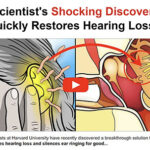This 30 Second Technique is Shockingly Effective
Bilateral Moderate Sensorineural Hearing Loss in Children: Early Intervention and Education

Understanding Bilateral Moderate Sensorineural Hearing Loss in Children
Defining Sensorineural Hearing Loss: Sensorineural hearing loss (SNHL) is the most common type of permanent hearing impairment. It occurs due to damage to the inner ear or to the nerve pathways from the inner ear to the brain. Unlike conductive hearing loss, which can often be corrected or improved, SNHL is typically irreversible. It can affect the ability to hear quiet sounds or reduce the clarity of sounds, making it difficult for individuals to understand speech.
Characteristics of Bilateral and Moderate Impairment: Bilateral moderate sensorineural hearing loss means that the hearing impairment is present in both ears (bilateral) and is of moderate severity. Children with this level of hearing loss may hear sounds between 40-70 decibels. They often struggle to hear conversational speech, especially in noisy environments, which can significantly impact their ability to communicate and interact with others.
Impact on Speech and Language Development: Hearing is critical for the development of speech and language skills. Bilateral moderate sensorineural hearing loss in children can lead to delays in speech and language acquisition, affecting educational and social development. Early detection and intervention are crucial to help minimize these impacts and support the child in developing effective communication skills.
Causes and Diagnosis of Bilateral Moderate Sensorineural Hearing Loss
Genetic Factors and Prenatal Causes: Many cases of bilateral moderate sensorineural hearing loss are attributed to genetic factors, which can either be inherited from the parents or occur due to new mutations. Prenatal factors such as maternal infections, certain medications, and complications during pregnancy can also contribute to the development of SNHL in children.
Environmental Causes and Acquired Conditions: Postnatal factors including infections like meningitis, exposure to ototoxic medications, or head trauma can lead to the onset of sensorineural hearing loss. Additionally, prolonged exposure to loud noise is a well-known environmental risk factor for hearing impairment in children and adolescents.
The Diagnostic Process and Early Detection: Diagnosis of bilateral moderate sensorineural hearing loss typically involves comprehensive hearing exams, including audiometry and tympanometry, and may also include genetic testing or imaging studies. Early detection through newborn hearing screening programs is fundamental to ensure timely intervention and support for the child and their family.
Early Intervention Strategies for Children with Bilateral Moderate Sensorineural Hearing Loss
Importance of Early Identification: The benefits of early identification of hearing loss cannot be overstressed. It enables prompt intervention, which is critical for the development of speech and language skills. Early identification also allows for quicker adaptation to hearing aids and other assistive devices, which can drastically improve a child's quality of life.
Hearing Aids and Assistive Listening Devices: For children with bilateral moderate sensorineural hearing loss, hearing aids are often the first line of treatment. These devices amplify sounds, making it easier for the child to hear. Assistive listening devices can also be used in conjunction with hearing aids to enhance hearing in particular settings, such as the classroom or at home.
Speech and Language Therapy: Alongside hearing augmentation, speech and language therapy is a cornerstone of early intervention. Speech-language pathologists work with children to improve their speech perception and production, language development, and communication skills, which are all essential for successful social and academic integration.
Education and Accommodation for Children with Bilateral Moderate Sensorineural Hearing Loss
Individualized Education Programs (IEPs): Children with hearing loss often require an Individualized Education Program, outlining specific goals and accommodations needed to access the curriculum effectively. An IEP is a collaborative effort among parents, teachers, and specialists to ensure that the educational needs of the child are met.
Classroom Accommodations and Assistive Technologies: Various accommodations such as preferential seating, captioning services, and FM systems can greatly assist children with bilateral moderate sensorineural hearing loss in an educational setting. Assistive technologies are also integral in enhancing access to learning materials and communication.
Communication Access and Inclusion Strategies: Ensuring that children with hearing loss are included in classroom discussions and activities is vital. Visual aids, sign language interpreters, and peer support programs can help facilitate inclusion and full participation in the school environment.
The Role of Family and Community in Supporting Children with Bilateral Moderate Sensorineural Hearing Loss
Parental Involvement and Advocacy: Parents play a pivotal role in the intervention process for children with hearing loss. From advocating for appropriate services to providing emotional support, the involvement of family members is key to the child's success and well-being.
Support Groups and Community Resources: Support groups can offer invaluable information and emotional support to families. Community resources such as specialized programs and services can also provide additional opportunities for learning and social interaction for children with hearing loss.
Fostering Social Interaction and Confidence: Encouraging positive social interactions and building confidence are essential for children with bilateral moderate sensorineural hearing loss. Participation in community events, sports, and other extracurricular activities can promote a sense of belonging and self-esteem.
Technological Advancements in Managing Bilateral Moderate Sensorineural Hearing Loss
The Latest in Hearing Aid Technology: Technological advancements have significantly improved the functionality and user-friendliness of hearing aids. Modern devices offer better sound quality, connectivity, and even customization options that cater to the specific needs of children with hearing loss.
Cochlear Implants and Other Surgical Options: For some children with bilateral moderate sensorineural hearing loss, cochlear implants may be an option. These devices bypass the damaged parts of the ear and directly stimulate the auditory nerve, providing an alternative means of hearing.
Remote Learning and Therapy Options: The rise of telehealth and remote learning has expanded access to specialized services for children with hearing loss. Online speech therapy and remote educational services can be particularly beneficial for families in rural or underserved areas.
Preparing for the Future: Life Skills and Independence for Children with Bilateral Moderate Sensorineural Hearing Loss
Developing Self-Advocacy Skills: As children with hearing loss grow, it's important for them to learn self-advocacy skills. Understanding their hearing loss, knowing their rights, and being able to communicate their needs are crucial for independence and self-confidence.
Transitioning to Higher Education and Employment: Preparing for higher education and the workforce involves building upon the foundation laid during childhood. It's important for adolescents with hearing loss to explore their interests and to be equipped with the necessary accommodations and support to succeed.
Long-term Support and Adult Services: As children with bilateral moderate sensorineural hearing loss transition into adulthood, continued support remains important. Adult services, vocational rehabilitation, and ongoing access to assistive technology can ensure that individuals with hearing loss lead fulfilling lives.

Laura Henderson is a health enthusiast and has been interested in healthy and natural methods of eliminating tinnitus and restoring natural hearing for many years.










